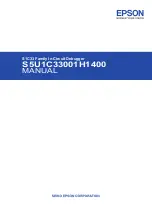
4. NAME AND FUNCTION OF EACH PART
S1C33 Family In-Circuit Debugger
EPSON 9
S5U1C33001H1400 Manual (Rev. 0.20)
4. NAME AND FUNCTION OF EACH PART
The following shows an external view of the S5U1C33001H1400’s operating section and the name of each part.
4.1 Left-side
panel
Fig. 3 Left-side panel
4.1.1
10-pin connector for connecting to target systems
This connector is used to connect to the target system using a 10-pin cable or 10-pin-4-pin cable.
4.1.2
30-pin connector (
not provided
) for connecting to target systems
This connector is used to connect to the target system using a 30-pin cable.
Note: This connector is not provided with the debugger unit. Please contact us if you need
this cable.
Note: Only one of the 10-pin connector for connecting to target systems and 30-pin
connector for connecting to target systems may be used at any given time.
4.1.3
4-pin connector for flash programmer power supply
This connector is used to output a reset signal to the target system or to supply power
(note) for flash programming. When the interface for debug signals requires a voltage level
for the target system, this connector is used to input the operating voltage from the target
system. For information on the connector pin configuration and connection method, refer
to “Connector for flash programmer power supply.”
Note: The S5U1C1700H incorporates a 7-V, 200-mA power supply for flash programming.
However, use of this power supply may not be possible with certain S1C processors.
If the technical manual for the target S1C processor does not specifically mention
this power supply, damage may occur in the chip due to overvoltage. To prevent this
problem, avoid using this voltage (do not set the DIP SW8 to ON) if this voltage is
not supported by the target S1C processor. Keep this pin open when implementing a
connection terminal on the target board.





























